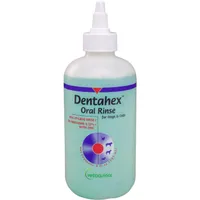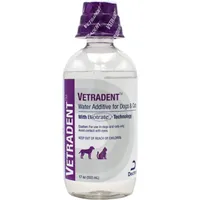Dog gum diseases and 5 vet-approved ways to prevent them
Dog gum diseases are some of the most common diseases vets see. Here are the steps you can take to protect your dog

Dog gum diseases are extremely common. While the exact number of dogs suffering with gum disease is unknown, it’s likely to be at least 60% of the doggy population, and maybe as much as 100%.
Gum disease is not only painful, it leads to other dental diseases such as periodontitis, which can cause tooth loss. Preventing gum disease is best, so let’s look at how we can stop dog gum diseases from happening.
Dog gum disease: what is it, and what causes it?
Gum disease (properly called gingivitis) happens when the body’s immune system reacts to bacteria known as plaque that sits on the tooth surface. This plaque can also harden into tartar (also known as calculus), which shelters the bacteria and provides it with somewhere to stick to.
With plaque and tartar in the mouth, the gums become red, inflamed, and sore. They may bleed and, after time, the gums come away from the tooth surface, allowing the bacteria to bury deeper – a disease called periodontitis.
All dogs have these bacteria in their mouths, but whether or not they go on to cause gingivitis and periodontitis is down to a number of things. Genetics, diet, breed, age, home care, and other factors all influence how quickly plaque will start to cause gingivitis.
In some breeds, gingivitis can occur in dogs under a year old – in fact, one study of Yorkshire Terriers showed that 98% had one or more teeth with periodontitis at just nine months old!
You might also want to read our guide to dog teeth rotting.
Get the best advice, tips and top tech for your beloved Pets
How to prevent and treat dog gum disease at home
Gum disease can start very early in life and cause severe problems. Prevention should start as early as possible and ideally should consist of several types of care.
1) Brush your dog’s teeth
Brushing your dog’s teeth at least every other day has been shown to reduce plaque and calculus build-up, as well as help to heal any existing gingivitis. Learning how to brush a dog’s teeth and doing it regularly helps to physically remove plaque and prevents it from accumulating, and it also stimulates healing in the gums.
You’ll want to start as young as possible and start slow so your dog can get used to it – and use one of the best dog toothbrushes. Meanwhile, the best dog toothpastes comes in a variety of flavors, which may help dogs enjoy toothbrushing and make it an easier experience all round.
Make sure you keep this a positive experience for your dog – little and often is better than going all-out and scaring him. We asked a vet for more advice on how often to brush a dog’s teeth.
2) Use dog mouthwash
There is some evidence that using mouthwash for dogs reduces the formation of plaque and calculus, and therefore gingivitis. Mouthwash may be added to drinking water or included as a post-toothbrush routine as with humans.
Whilst there are many types of mouthwash on the market, chlorhexidine-based washes have the best evidence in dogs.
Vetoquinol Dentahex Pet Oral Hygiene Rinse
This canine dental spray combats bad breath and is proven to help control plaque and tartar to support healthy gums. A much easier application than brushing, this mouth rinse is great for fussy pets.
Dechra Vetradent Water Additive for Dogs and Cats
This easy-to-use water additive contains zinc chloride and citric acid to reduce bad breath and restore pH balance. It is odorless, tasteless and colorless.
3) Switch your dog’s diet

Your dog’s diet can make a difference to their dental health too! Studies have shown that the larger kibble size in some of the best dry dog food reduces calculus as dogs have to chew them more thoroughly. Diets with added sodium tripolyphosphate also help – this chemical prevents plaque from hardening into tartar. In fact, one study showed that dogs fed a diet developed for dental health every day had a 36% reduction in gingivitis compared to the dogs on a normal dry diet.
There’s also some evidence that dogs fed a home-cooked diet will have worse plaque and tartar than those on a commercial dry diet – even if the commercial diet isn’t specifically designed for dental health.
4) Feed daily dental chews
Many daily dental chews have enough evidence to say they’re useful in the fight against gingivitis. Research has shown that feeding a daily dental chew can reduce plaque, tartar, gum disease, and bad breath.
There are lots of dental chews out there, though, and some have better evidence than others. For the best dental chews for dogs, look for those that have the VOHC seal of acceptance in order to be sure you’re using an evidence-based chew.
You should also take care with your dog’s weight. Some dental chews can be high in calories, and cause weight gain. Always give the right chew for your dog’s size. The calorie information should be on the packet but, if it’s not, you can look the information up on the manufacturer’s website. Reduce your dog’s daily meal allowance by the same amount of calories to balance out the chew.
Pedigree Dentastix Large Dog Dental Treats
These treats offer triple action dental care by freshening breath, cleaning teeth and removing the build-up of plaque and tartar.
5) Get regular check-ups at the vet
Whatever you manage to do at home, remember that regular checkups at the vet are important too. Your veterinary nurse, tech, or vet will be able to examine your pet’s mouth for bad breath, gingivitis, and tartar build-up, as well as look for any broken, loose, or malformed teeth that might be causing a problem.
It’s also important to realize that a thorough dental check-up is best done under anaesthetic, and your dog can have a scale and polish whilst they’re under to clean up the bits you’ve missed. Even if nothing appears to be wrong, annual cleaning under anesthetic is sensible, especially in at-risk dogs. I always say to clients “you brush your teeth twice a day and you still visit the hygienist, right?”
How do vets treat dog gum diseases?
If you suspect your pooch has fallen victim to dog gum diseases, consult your vet without delay.
Diagnosis and treatment
“If your vet diagnoses your pet with gum disease, they will usually recommend dental treatment,” says vet Dr Rebecca MacMillan. “Your dog will be admitted for a general anesthetic so that your vet can safely assess and treat your dog’s dental issues properly. Your vet will scale all the calcified tartar from your dog’s teeth and assess their gums, using a dental probe. Dental radiographs may be used too.
“If there are any loose or diseased teeth these will be extracted. A professional cleaning will reduce bacteria in your dog’s mouth, not only improving bad breath but also reducing gum inflammation. Polishing the teeth at the end will help to remove any plaque, the slimy layer of bacteria, and microscopic food particles.”
Aftercare and routine home care
Once your dog’s teeth have been assessed, scaled and polished, it’s the owner’s job to perform good routine maintenance. “Your vet will usually suggest that you follow this up with oral care at home,” explains Dr MacMillan. “This could include regular teeth brushing, oral pastes, or a diet aimed at preventing future tartar accumulation. Some pets may need to come back for repeat veterinary dental procedures in the future to keep on top of things.”
For Dr Macmillan, following a vet’s recommendations is the best way to minimize recurrence of dog gum diseases.
“Being proactive with your dog’s oral care will help to preserve their teeth for as long as possible,” she advises.
“Be aware that non-veterinary treatments, such as those offered by dog groomers, may help to make your pet’s teeth look cosmetically better but can still leave many problems behind.”
If you’ve found this useful, you may also enjoy our advice on how to clean a dog’s teeth without brushing and other tips for keeping dog teeth clean.

Dr MacMillan is a companion animal vet who has always had a passion for writing and client communication. She works in the South West and loves complex medical cases.

Bethany is an experienced writer who has been writing across the pets and equestrian sector for eight years.
After graduating as a vet from the University of Nottingham in 2016, Dr. Joanna Woodnutt went on to practice companion animal medicine in the Midlands. She quickly developed a love of consulting and helping clients with medical problems such as dermatology, behavior and nutrition - anything that involved helping clients understand their pets better.
Jo started writing about pet health in 2017, realizing that it meant she could help even more pet parents. Since then, she has written for countless online and print publications and is a regular contributor for Edition Dog Magazine. Jo is the director of The Veterinary Content Company, which she founded in 2020. She is also the founder of Petlearnia, a platform that provides pet e-learning courses for pet parents.
Jo now lives in the Channel Islands with her husband Ian and terrier Pixie.
- Bethany StoneFreelance Writer
- Dr. Rebecca MacMillanVet




